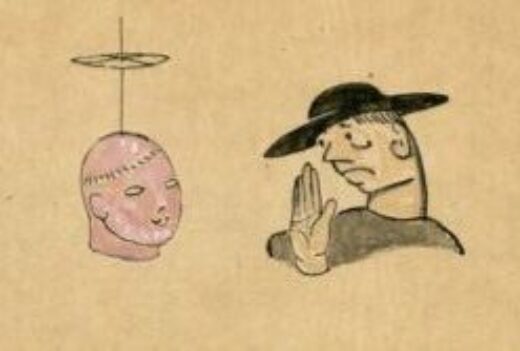
Printed
4 pages
Author(s)
It is too much
The Drama for Fools is a broad cycle containing multiple interludes, including It Is Too Much. This cycle kept Craig exceedingly busy between 1916 and 1918. It was supposed to hold 365 short plays and be performed like a traveling show: each night, from 31 April to 31 March, a new play would be shown in a new location. Craig, who wrote his plays under the pen name Tom Fool, stopped writing before the cycle was finished and gave up on performing the play himself.
Nonetheless, he stored his drafts in three cardboard boxes, as a collection of typewritten notebooks containing many illustrations and whose covers display words written in colourful calligraphy. He cared immensely for these notebooks, as he improved, corrected, and supplemented them until the 1950s. This collection is today held at the Institut International de la Marionnette in Charleville-Mézières.
This interlude deals with one of Craig’s favourite themes in The Drama for Fools project: hypocrisy and, more particularly, the prudish criticism of freedom in morals of poets and artists. He was a ladies’ man and the father of a dozen children that he had with six different women. He first thought of starting his great puppet drama cycle by mentioning Lord Byron, who was known for his multiple affairs. The interlude is preceded by seven epigraphs, all excerpts of letters accusing people of licentiousness: Shelley against Woodsworth, Shelley regarding Byron, Godwin in regard to Shelley, Shelley concerning Michelangelo, and even from Harriet Shelley against her husband.
Craig suggests in the margin of a drawing that can be found in a manuscript of the play (Ms A 52, BnF) that his character was inspired by an old priest of Marina di Pisa.
Some men are outraged by other men’s vice, while concealing their own
A Priest, whose face looks like those painted by Fra Angelico, gets out of his house, smiling at life. While hearing noise from the modern city and the industrial world, he changes his expression and his voice to better fit the expectations of a churchman. He sees a Soldier and accuses him of having a mistress. The Soldier tells him that his wife is living with the Lawyer. The Lawyer comes and shares his disapproval concerning the Merchant, who openly commits adultery with the Doctor’s wife. The Merchant then exposes the affair between the Doctor and the Actor’s wife, as well as the one between the Actor’s wife and the Doctor’s wife and the Doctor’s daughter’s passion for the Actor. Each of these revelations is followed by the exclamation “It is too much!” from the previous characters, and with a change of expression emphasizing the hypocrisy of their outrage. The Doctor and the Actor enter together, and the Doctor declares that all the women of the village are in love with the Poet. All men rush to their homes to find their wives. The Priest remains alone and asks Mary, his servant, who we can tell is his partner, to set the table to receive the Poet for lunch. He will be accompanied by all of his wives and the children he had with them. The play ends when the children get on stage, through a door opening in the sky and under a rain of rose petals.
Publications and translations
Edward Gordon Craig, The Drama for Fools / Le Théâtre des fous. Montpellier: L'Entretemps, 2012.
Edward Gordon Craig, The Drama for Fools / Le Théâtre des fous. Montpellier: L'Entretemps, 2012.
(French)
